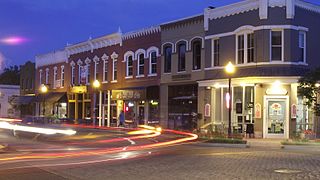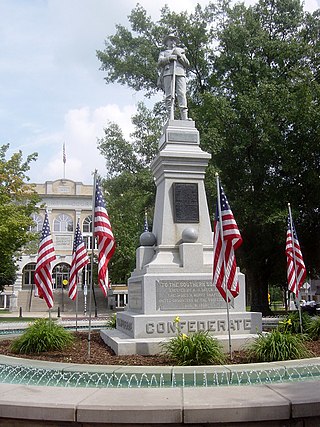
Bentonville is the tenth-largest city in Arkansas, United States and the county seat of Benton County. The city is centrally located in the county with Rogers adjacent to the east. The city is the birthplace of and world headquarters location of Walmart, the world's largest retailer. It is one of the four main cities in the three-county Northwest Arkansas Metropolitan Statistical Area, which is ranked 105th in terms of population in the United States with 546,725 residents in 2020, according to the United States Census Bureau. The city itself had a population of 54,164 at the 2020 Census, an increase of 53% from the 2010 Census. Bentonville is considered to be one of the fastest growing cities in the state and consistently ranks amongst the safest cities in Arkansas. It is included in the Fayetteville–Springdale–Rogers Metropolitan Statistical Area.

Highway 72 is a designation for two east–west state highways in Benton County, Arkansas. A western route of 26.32 miles (42.36 km) runs east from Highway 43 at Maysville to U.S. Route 71B (US 71B) in Bentonville. A second route of 12.67 miles (20.39 km) begins at Interstate 49/US Route 71 (I-49/US 71) in Bentonville and runs northeast to US 62 near Avoca. The route is one of the original Arkansas state highways.

Hillcrest Historic District is an historic neighborhood in Little Rock, Arkansas that was listed on the National Register of Historic Places on December 18, 1990. It is often referred to as Hillcrest by the people who live there, although the district's boundaries actually encompass several neighborhood additions that were once part of the incorporated town of Pulaski Heights. The town of Pulaski Heights was annexed to the city of Little Rock in 1916. The Hillcrest Residents Association uses the tagline "Heart of Little Rock" because the area is located almost directly in the center of the city and was the first street car suburb in Little Rock and among the first of neighborhoods in Arkansas.

The Central Park West Historic District is located along Central Park West, between 61st and 97th Streets, on the Upper West Side of Manhattan in New York City, United States. The district was added to the National Register of Historic Places on November 9, 1982. The district encompasses a portion of the Upper West Side-Central Park West Historic District as designated by the New York City Landmarks Preservation Commission, and contains a number of prominent New York City designated landmarks, including the Dakota, a National Historic Landmark. The buildings date from the late 19th century to the early 1940s and exhibit a variety of architectural styles. The majority of the district's buildings are of neo-Italian Renaissance style, but Art Deco is a popular theme as well.

The Stroud House is a historic house at SE F Street and East Central Avenue in Bentonville, Arkansas. It is a 1+1⁄2-story wood-frame structure, with asymmetrical massing and decorative shinglework typical of the Queen Anne style, and a shed-roof front porch supported by Colonial Revival columns. It is a high-quality local example of this transitional style of architecture, built in 1903 by Daniel Boone Laine and Delila Laine. The property also includes remnants of a 1925 gas station.

The Wilson Park Historic District is a historic district in Fayetteville, Arkansas, USA, located just northeast of the University of Arkansas. The district consists of several residential buildings that developed during the late 19th and early 20th Century near Wilson Park just north of Dickson Street, the city's primary entertainment district. Wilson Park Historic District includes 47 contributing buildings.

John Parks Almand was an American architect who practiced in Arkansas from 1912 to 1962. Among other works, he designed the Art Deco Hot Springs Medical Arts Building, which was the tallest building in Arkansas from 1930 to 1958. Several of his works, including the Medical Arts Building and Little Rock Central High School, are listed on the National Register of Historic Places.

Downtown Bentonville is the historic business district of Bentonville, Arkansas. The region is the location of Walmart Home Office; city and county government facilities; and most of Bentonville's tourist attractions for the city and contains many historically and architecturally significant properties. Downtown measures approximately 1.5 square miles (3.9 km2) and is defined as the region between Tiger Boulevard to the north, Highway 102 (AR 102) to the south, Walton Boulevard to the west and J Street to the east. Similar to other central business districts in the US, Downtown has recently undergone a transformation that included the construction of new condos and lofts, renovation of historic buildings, and arrival of new residents and businesses. Upon opening of Crystal Bridges Museum of American Art the increased tourist traffic related to the museum has made Downtown Bentonville one of the state's most popular tourism destinations.

Washington–Willow Historic District is a residential neighborhood of Fayetteville, Arkansas containing over one hundred historically and architecturally significant homes. Styles range from those popular in the mid-19th century through present day, predominantly Victorian, Italianate, neoclassical, and craftsman bungalows. Historically, Fayetteville leaders in business, law and education have all called the district home. The homes sit at the foot of East Mountain within the Masonic Addition, the first addition platted following incorporation.

U.S. Highway 71 is a U.S. highway that runs from Krotz Springs, LA to the Fort Frances–International Falls International Bridge at the Canadian border. In Arkansas, the highway runs from the Louisiana state line near Doddridge to the Missouri state line near Bella Vista. In Texarkana, the highway runs along State Line Avenue with US 59 and partially runs in Texas. Other areas served by the highway include Fort Smith and Northwest Arkansas.

The Hotel Massey is a former hotel in the Downtown district of Bentonville, Arkansas, built in 1910 in the Renaissance Revival architectural style. The historic property replaced the Eagle Hotel, which had been on the site since 1840. Many businesses have occupied the hotel's first floor, and the structure has contained the Bentonville Public Library twice. Coupled with Massey Hotel's community heritage, the building's architectural style is uncommon in Arkansas, and even more rare in the Ozarks. With this duality of significance, the property was added to the National Register of Historic Places in 1978.

The North Elm Street Historic District is a predominantly residential historic district in Hope, Arkansas. The district is rectangular in shape, roughly bounded on the north by Avenue G, on the west by Hervey Street, on the east by Hazel Street, and on the south by the railroad tracks. Most of the residential structures in this area were built between 1890 and 1945, and represent the city's greatest concentration of homes built during its boom years. The only major institutional building in the district is Hope City Hall, a Classical Revival structure.

The East Hamilton Avenue Historic District encompasses a 20th-century residential area of Wynne, Arkansas, reflective of its growth between about 1920 and 1940. It extends along East Hamilton Avenue, between North Falls Boulevard and Killough Road, and includes properties on Eldridge Court. East Hamilton Avenue, representing the best-preserved area of development from this period, was developed gradually beginning in the late 19th century, and grew from west to east. The oldest house in the district, the Giboney-Robertson-Stewart House, is a Queen Anne Victorian built c. 1895. Most of the houses were built after 1920, and are predominantly Craftsman, Colonial Revival, and Tudor Revival in character. There are a few Spanish (Mediterranean) Revival houses, and a few early ranch houses, which were generally built between 1940 and 1950.

The West Washington Avenue Historic District of Jonesboro, Arkansas, encompasses a concentrated grouping of residential buildings built between 1890 and 1930. It represents the best-preserved section of the city's first planned subdivision, including thirteen historic properties on a 1-1/2 block stretch of West Washington Avenue extending east from Mclure Street and beyond Flint Street. Stylistically these houses represent a cross-section of architecture popular in the period, including Queen Anne Victorians and Tudor Revival structures. Most of the houses are built of brick, and there is one church.

The Bentonville Third Street Historic District is a residential historic district just southeast of the central business district of Bentonville, Arkansas. It covers two blocks of SE Third Street, between Main and B Streets, including fourteen properties on Third Street and adjacent cross streets. This area, developed principally after the arrival in Bentonville of the railroad in 1881, is reflective of the high-style architecture of the late 19th and early 20th centuries that had not previously been widespread in Benton County. All of the houses are one to 2+1⁄2 stories in height, and all are wood frame, except the Elliott House, a brick house with an eclectic combination of Italianate and Second Empire styles.

The Craig-Bryan House is a historic house at 307 West Central Avenue in Bentonville, Arkansas. It is an eclectic two-story brick house, with several gabled wings, and projecting bay window sections. Its front-facing gable ends are decorated with bargeboard, and there is a prominent three-story tower at the center with a shallow-pitch hip roof. Its iron balconies were salvaged from the old Benton County Courthouse when it was demolished. The house was built in 1875 by James Terrill Craig, and owned by members of the Bryan family for seven decades.

The Linebarger House is a historic house at 606 West Central Avenue in Bentonville, Arkansas, U.S.A. This two-story Craftsman-style house was built in 1920 by C. A. Linebarger, one of the principal developers of the Bella Vista resort area north of Bentonville. As one of the first Craftsman houses built, it played a significant role in popularizing the style in the region, with a deep porch whose roof is supported by stone porch piers, wide eaves with decorative supporting brackets, and exposed rafter tails.

The May–Lecta–Sweet Historic District encompasses a predominantly residential area of Fort Smith, Arkansas that was developed between 1890 and 1950. It is located in a large residential area east of Fort Smith's downtown, and extends along May and Lecta Streets between Rogers and Kinkead Avenue, and a short stretch of Sweet Avenue between Barry and Rogers. The streets are tree-lined, and the area was considered suburban when it was platted and development began in the 1890s. The houses of the district are mainly Colonial Revival and Craftsman in their style reflective of the principal period of development, between about 1900 and the early 1930s. The area was served by streetcars until the 1930s.

The Quapaw–Prospect Historic District is a predominantly residential historic district on the northwest side of Hot Springs, Arkansas. It covers a roughly nine-block stretch of Quapaw and Prospect Streets, from their junction in the east to Grand Avenue in the west, including properties on streets running between the two. The area was developed between about 1890 and 1950, and contains a cross-section of architectural styles popular in that period. Although Colonial Revival and Craftsman style houses dominate the area, it has a particularly fine collection of Queen Anne Victorians as well.

The Robinson Historic District encompasses the oldest residential neighborhood of Conway, Arkansas. It is located just west of the city's downtown business district, and is bounded on the east by Faulkner Street, the south by Robinson Avenue, the west by Watkins Street, and the north by Ash, Caldwell, and Davis Streets. It contains a cross-section of residential architectural styles covering the city's development between 1890 and 1950. The district is named for Asa P. Robinson, Conway's founder.






















